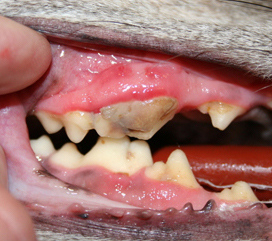Dental Care
Deciduous teeth
Cats and dogs have two sets of teeth during their lives, just like humans. The baby or deciduous set is lost by 7 to 8 months of age. Very few problems arise from this first set of teeth, with the exceptions of retained or broken deciduous teeth and malocclusions.
Tooth decay
Tooth decay and gingivitis are very common health risks in our pets. As in man, the disease starts with plaque accumulating on all the enamel surfaces of the teeth. Plaque is a slimy film of multiplying bacteria, trapping carbohydrates from the food and minerals from the saliva. This film becomes thicker over time and starts to encroach on the gums. The body mounts an inflammatory response against the bacteria giving rise to gingivitis, (red painful gums).

If the plaque is not removed by brushing or vigorous chewing, gum disease escalates. As the slimy film thickens more, more minerals start to accumulate in it. Soon tartar or calculus becomes visible as hardened brown-green accumulations on the teeth. The bacteria in tartar produce bad smelling gases which cause halitosis (bad breath) and they also produce dissolving chemicals that break down the tissues anchoring the teeth in the bony tooth sockets. The end stage of this process is persistent infection of the teeth support structures resulting in abscesses and loss of teeth.
Dental prophylaxis and surgery
This disease is preventable. The key to preventing dental disease is to stop plaque from becoming established on the teeth. This is achieved by choosing the correct type of food to stimulate chewing behaviour in dogs, cats, carnivorous reptiles, and gnawing in rabbits and rodents. The staff will be very happy to guide you through the multitude of food options to get the best for your pet. Brushing dogs and cats teeth is very important and rewarding. With some persuasion and some help you should be able to master this skill with your pet.
Dogs and cats with tartar on their teeth and minimal gingivitis can be treated by scaling and polishing all the teeth in the mouth. This is very similar to us having our teeth cleaned by an oral hygienist. The difference is that a veterinary patient requires an anaesthetic to perform the procedure.
If we are unable to prevent the disease, and tartar builds up to a point where gingivitis and periodontal infection is severe, gum surgery and even dental extractions may be required.
In addition to treating gum disease, dental procedures and oral surgery may also be part of the treatment for other infectious, traumatic or cancer diseases. Johnny has many years of experience in managing complex dental cases and the whole team at KGVS are skilled and equipped to manage more complicated surgeries and their perioperative care.
Contact Us


